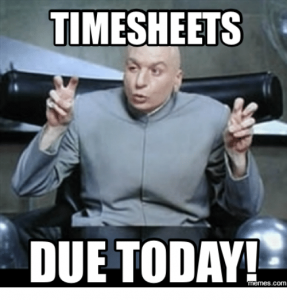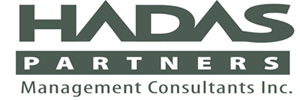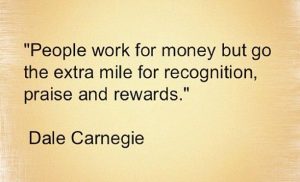Recognition and rewards elicit a mixed response. On one hand most people agree (in principle) that recognizing merit, and/or constructive behaviours, is a good thing. “We should do it more”, we often hear people say. On the other hand, when discussing recognition and rewards, most people think of corporate recognition programs which by and large are perceived as either ineffective, costly or both.
So there’s your hint when thinking of implementing a recognition and reward program: it’s not the activity, but how it’s implemented, that is important. Corporate recognition programs tend to be perceived as ineffective when they are not tied to any specific results, or when management is seen using such a program to paper over real issues within the organization.
So what is an effective reward and recognition program? Rather than write about this theoretically, it’s best to share with you an example of such a program that worked very well for one of our clients. Maybe you can use this idea on your project.
But first, a quick summary of what makes a recognition and reward activity effective.
The only measure of a reward and recognition activity is that it is tied to objectives. In our case these tend to be project objectives. In other words, this activity must produce measurable results. That’s it. Nothing else. Before you start implementing a reward and recognition activity define what you want it to achieve. Even better, imagine what the graph will look like when you present the results to your executive, or steering, committee.
Story of a Successful Reward and Recognition Activity
This example involves a project to upgrade systems at a professional services organization. One of the changes included replacing their current stand-alone solution for time tracking with the solution that was part of their new ERP system.
 For those of you not familiar with professional services firms (e.g., consulting or law firms), tracking the time their professionals spend on client work is a serious matter. It’s what drives billing, cash flow and profitability. At the same time, filling in timesheets is not the most favorite activity that these professionals do. Actually, it is on par with filling out tax forms and just above getting a root canal.
For those of you not familiar with professional services firms (e.g., consulting or law firms), tracking the time their professionals spend on client work is a serious matter. It’s what drives billing, cash flow and profitability. At the same time, filling in timesheets is not the most favorite activity that these professionals do. Actually, it is on par with filling out tax forms and just above getting a root canal.
So, changing anything to do with the timesheet process is not going to be popular. On top of this, our client was in the middle of an organization-wide initiative to improve work-life balance. This was a strategic initiative to attract and recruit more female practitioners, and retain those already there.
Why is this relevant? Well, in the current system time sheets had to be submitted by noon on Monday. That’s about as perfect as you can get with timesheets. It means that the professionals could wrap up client work on Friday, fly back home where necessary, and do their timesheets later. This would be either Sunday night when preparing for the next week’s work, after the kids go to bed. Or on Monday morning, at the desk, before the day gets going, with a cup of coffee at the side. All very civilized!
Well, the new system required for time sheets to be submitted on…
wait for it…
wait for it…
The Challenge
…Saturday evening at 6 pm!
Wow, how great does that look? Work-life balance? You can see the family getting ready for dinner Saturday afternoon when Mom or Dad says, “Honey, go ahead and have dinner with the kids, I’ll join you later. I have a bit more work to do.” What could possibly go wrong in that relationship if this keeps going?
So, this implementation was not going to be popular. Yet in our case it was spectacularly successful. Here are all of the steps we took.
One: ‘Decouple’ the ERP system from the process
 This is one of our preferred approaches where ever possible. The problem is that ERP implementations impose a lot of changes all at once. The more you can decouple some of these changes and implement them early you reduce the total change impact on the day of implementation. Plus there is the added benefit of people adjusting to changes gradually, over time.
This is one of our preferred approaches where ever possible. The problem is that ERP implementations impose a lot of changes all at once. The more you can decouple some of these changes and implement them early you reduce the total change impact on the day of implementation. Plus there is the added benefit of people adjusting to changes gradually, over time.
So we moved the implementation of time sheet submissions up by 4 months. It became a policy change rather than a system imposed one (it’s harder to oppose policy changes as well because you are then in essence fighting your bosses). Together with this, we provided helpful tips on how to make this easier (i.e., submit your hours prior to leaving client, on the flight back, etc., and enjoy the weekend better).
These tips were all valid anyway. Remember, the shift in timesheet submission times was more of a problem of optics than a real logistical challenge. However, all of this still necessitated a focused communication campaign to get those messages across.
Two: Track compliance
This was harder than it sounds. The current system only reported when timesheets were late, not when they were actually submitted. So a manual report was required. To support this the firm provided an administrative resource to physically enter which individuals submitted their timesheet on time into a spreadsheet.
This was no small feat. Our client was a multinational firm and this implementation included the entire Canadian practice and four US business units. Each week there were hundreds of timesheet entries that had to be entered.
We are to this day eternally grateful to this administrative assistant who did this for us. In the end we insisted on special recognition for her efforts and awarded her the same reward we gave out to the practitioners (more on that in a minute).
Ultimately, the result was that each week we had a list of individuals who had submitted their timesheets before the Saturday 6 pm cut off time.
Three: Recognize and Reward
 And here is the fun part! This is how we recognized and rewarded those that complied.
And here is the fun part! This is how we recognized and rewarded those that complied.
The project acronym for this project happened to be the name of a type of wine. So we decided to play with this! The name was a gift to us. Let’s say the name of the type of wine was Shiraz (not the actual name).
So what did we do? Well, first we approached our CFO, who was also executive sponsor with our idea to ensure it was appropriate and palatable (financially, that is). Being a wine connoisseur, he loved our idea. And our idea was to pull from a virtual ‘hat’ names of 10 individuals who had submitted their timesheets on time, the new time. And each winner would get a bottle of Shiraz!
Four: Publicize
Was this popular? More than we could have anticipated!
What was also important was that we made weekly announcements who had won the bottles of Shiraz, complete with pics of happy, laughing recipients. Within two weeks many practitioners were eager to win the wine (and it was good quality wine, FYI – if you are going to reward, make sure it feels like a real reward).
Suddenly the Saturday 6 pm deadline was a ‘funline’ or at least a ‘non-eventline’.
Five: Measure
All of this so far is all fun and nice, but projects are business after all. We had to show results. Otherwise all we would have been is a bunch of fun, kumbaya consultants.
And the results were quite exceptional, actually. Our project implementation was phase 2. Phase 1 was a roll out to one of the US business units. When we went live the compliance rate to the new timesheet deadline was higher across all of our business units than the current compliance rate in the phase 1 organization. And that was after they had almost a full year of working within the new system!
And we continued to measure. This was no blip, no anomaly. The phase 2 compliance rate across all phase 2 business units remained high and above that of the phase 1 business unit. We had changed habits. Our project team changed the culture.
Some caveats
As great and motivating this story may be, this approach would not work everywhere. You have to be sensitive and get creative. Every environment is different.
For example this approach would not work in certain countries and organizations. We were after all giving away alcoholic beverages. That can be a real problem, but one that can be potentially overcome with a different type of product.
This approach also wouldn’t work in most unionized environments. Union contracts typically forbid rewards for anything that isn’t based on seniority. You may get away with token gifts to managers (who usually are not unionized) but then you run into exacerbating the ‘us-vs-them’ dynamics that are often present in these organizations. Plus, you can be derided for tokenism if the reward is a low value coffee gift card, for example.
Some organizations forbid their employees receiving gifts of any kind. This is usually in order to prevent influence and low-level corruption, but tends to extend very broadly in such organizations. Even if it doesn’t extend to a reward and recognition program, in these organizations receipt of gifts is perceived as a negative, culturally. So people tend do not appreciate receiving gifts anyway, and therefore any potential positive impact is lost.
In all of these situations you have to get creative. And in some cases, a recognition and reward program is just not possible, or is not worth the effort. In those cases you  have to rely on the other organizational change management tools to move behaviour along the desired spectrum.
have to rely on the other organizational change management tools to move behaviour along the desired spectrum.













